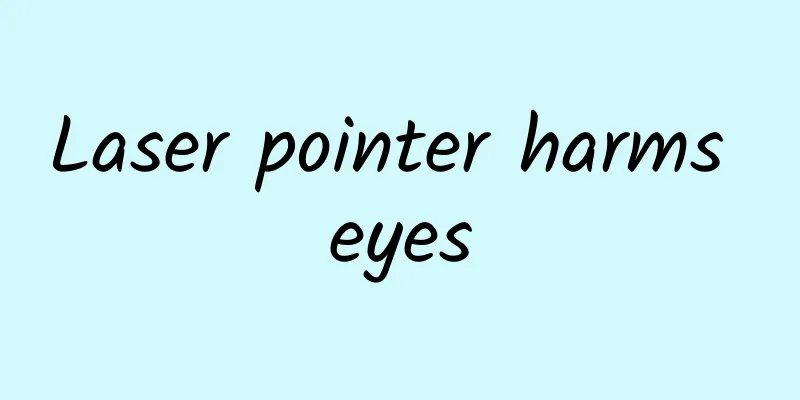Laser pointer harms eyes

|
I believe that many people like to play with laser pens in their daily lives, because laser pens are great in appearance and effect, and are very attractive in daily life. Laser pens can also emit different colors, which are great for playing and playing. However, playing with laser pens in the dark for a long time will cause damage to the eyes, because the laser itself can hurt the eyes. Does this have anything to do with the "lights" mentioned earlier? In fact, these beautiful lights are lasers emitted by small laser transmitters, and it is harmful to shine them directly into your eyes. Laser is the abbreviation of light amplification by stimulated emission of radiation. The English word laser is the abbreviation of the first letters of light amplification by stimulated emission of radiation. Laser achieves light amplification through stimulated emission of radiation. The difference between it and ordinary light is that ordinary light (such as the sun and electric lights) is emitted in all directions, and its amplitude, frequency, and phase are chaotic, while laser propagates in one direction, and its amplitude, frequency, and phase are neat and orderly. Therefore, it has the characteristics of good monochromaticity, strong directionality, and high brightness. Due to the high brightness of lasers, the energy generated by low-power lasers is almost the same as sunlight. The result of frequent exposure to lasers is the same as frequently looking at dazzling sunlight. The mechanism of laser damage to human eyes is very complex, and there are three main destructive effects: 1. Thermal effect: After the laser is absorbed by the tissue, it is converted into heat energy, and the local temperature rises, which destroys the protein and damages the cells. 2. Shock wave effect: The retina is exposed to strong light for a short period of time. Due to the impact of photons and the rapid thermal expansion of the irradiated tissue, shock waves are generated and spread to the surrounding tissues, causing injury. 3. Photochemical effect: Laser irradiation of eye tissue causes the vibration of atoms and molecules in the tissue, generating electromagnetic effects and ionization, causing damage to the tissue. Laser damage to the eyes is often caused by several effects acting simultaneously. The human eye is the part of the human body that is most vulnerable to laser damage. This is because the retina and other tissues can effectively absorb lasers of multiple wavelengths, and the eyeball itself has a good focusing system, which increases the light energy density of the laser entering the pupil and reaching the retina. Therefore, the damage threshold of laser to eye tissue is much lower than that of other organs, and the macula is more sensitive. Moreover, the biological effects of lasers can be cumulative. A single exposure may not cause damage, but multiple exposures may cause damage. Victims of repeated laser eye exposure often have no obvious complaints, but only feel a gradual decrease in vision. The location of laser damage to eye tissue is related to the wavelength of the laser. Ultraviolet light below 300nm cannot pass through the refractive medium of the eye and is almost completely absorbed by the cornea, which can cause photoelectric conjunctivitis; ultraviolet light between 300nm and 400nm is mainly absorbed by the lens, which can cause radiation cataracts; visible light between 400nm and 800nm and near-infrared light between 800nm and 900nm can pass through the refractive medium to reach the retina, where it is absorbed by pigment cells, causing retinal burns or even bleeding; infrared light above 950nm can be absorbed by the refractive medium of the eye and damage the superficial tissues of the eye in the form of thermal radiation: the cornea, lens, etc. Laser damage to eye tissue is also related to other factors. For example: the greater the energy of the laser, the greater the damage to the eyes; the smaller the angle at which the laser irradiates the eye, the greater the damage, because the smaller the angle of incidence, the smaller the light spot formed on the retina, and the more concentrated the energy density; if the eyes look directly at the laser beam, the laser is focused on the fovea of the retina, which has a greater impact on vision; retinal damage is more likely to occur at night than during the day, because the pupil is dilated at night, and when exposed to laser radiation of the same energy density, the retina receives more laser energy. According to national standards, the laser power with an irradiation time of more than 0.1 second cannot exceed 10-4 watts, which is the safety threshold of the laser. The laser lights we come into contact with in our daily lives generally do not exceed this standard, but frequent exposure to lasers without paying attention to protection can still cause chronic damage. Once eye damage occurs, it is too late to remedy the situation because the death of retinal photoreceptor cells and pigment cells caused by laser is irreversible. Therefore, in our daily lives we must pay attention to protecting our eyes, try to avoid laser exposure, and never look directly at the laser out of curiosity or fun. |
<<: What are the eye diseases and their symptoms
>>: What should I do if my eyesight is getting worse? How can I quickly eliminate eye bleeding?
Recommend
How long does it take for Quanlu Pills to take effect?
Generally speaking, Chinese medicinal materials a...
How to treat stuttering in old age
Stuttering is a common language disorder in life....
What are the characteristics of a short pulse?
Pulse deficiency mainly refers to the pulse rate ...
Is moxibustion on Sanyinjiao acupoint good?
Sanyinjiao is a common moxibustion point. Moxibus...
Why does drinking Astragalus cause dry mouth?
In life, many people take traditional Chinese med...
There are white spots on the baby's body
When a baby is just born, his physical fitness is...
Treatment of urticaria
Wheals are actually an acute form of urticaria. T...
What medicine can cure fatty liver quickly?
After suffering from fatty liver, drug therapy is...
Brown discharge from the body
After pregnancy, you must pay more attention to c...
What to do after being bitten by a black bug?
It is inevitable that there will be some biting i...
How to do a breast examination
In the physical examinations organized by the com...
What is the Chinese medicine method for treating Crohn's?
Many people may not have heard of Crohn's dis...
What are the dietary taboos for high blood sugar? Three foods to avoid
In life, if people have high blood sugar, they sh...
Women, don't take your knees lightly.
Strong knee joints are the prerequisite for free ...
Can scraping reduce fever?
The seasons are changing very quickly now, so man...









